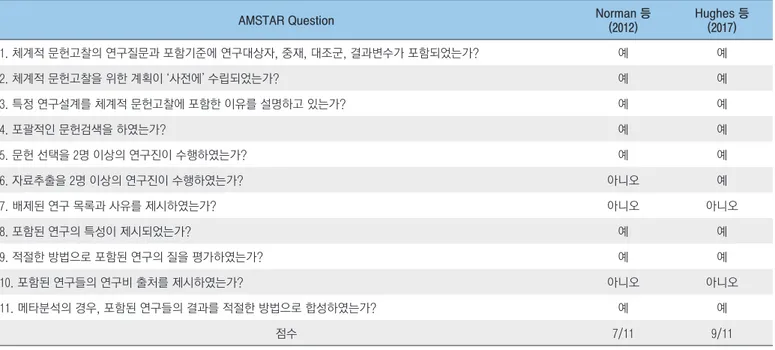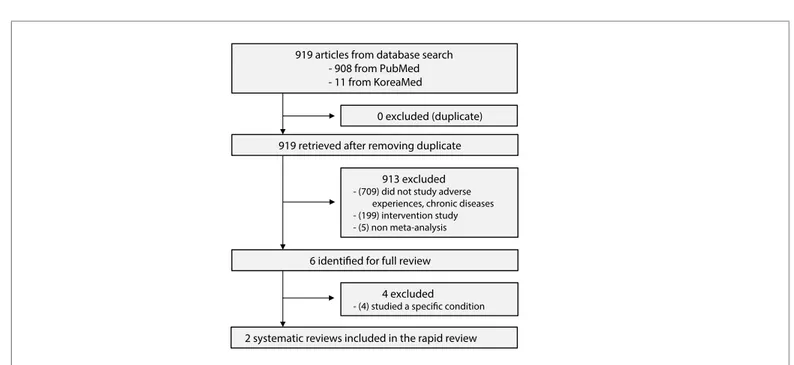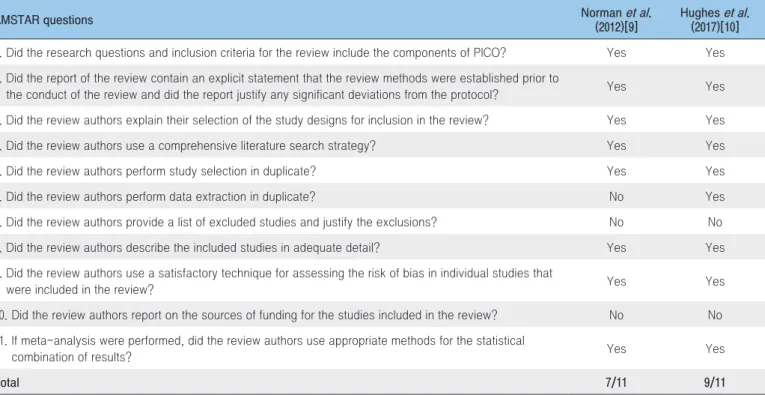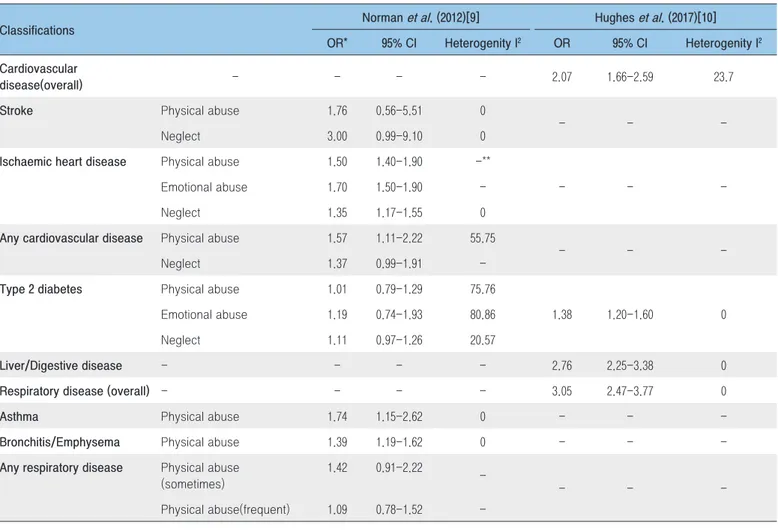아동기의 부정적 경험과 성인기 이후 주요
만성질환의 연관성 : 신속 문헌고찰
질병관리본부 질병예방센터 만성질환예방과 송금주, 김일열* *교신저자 : k8848@korea.kr, 043-719-7430 아동기의 부정적 경험이 성인기 이후의 정신적·신체적 건강에 영향을 미친다는 연구들이 활발히 진행되고 있다. 본 연구에서는 신속 문헌고찰 방법론을 적용하여 아동기의 부정적 경험과 주요 만성질환과의 연관성을 검토하였다. 체계적 문헌고찰 2편을 검토한 결과, 심혈관질환, 제2형 당뇨병, 간 또는 소화기질환, 호흡기질환 발생과 아동기의 부정적 경험 사이에 유의한 연관성을 보였으며, 특히 호흡기질환은 연관성이 3.05배까지 큰 것으로 나타났다. 국가적 조사체계를 수립하여, 아동기 부정적 경험 관련 현황을 파악하고 주요 만성질환과의 연관성을 밝혀 아동기 부정적 경험을 예방하고 관리할 수 있는 프로그램 및 정책 개발이 필요하다. 주요 검색어 : 아동기 부정적 경험, 만성질환, 체계적 문헌고찰초 록
들어가는 말
우리나라 아 동학대 관련 최근 통계에 따르면, 2018년
아 동 보 호전 문기 관 에 서 집 계 된 전 체 신고접 수 건 수 는 총
36,417건이며, 2017년에 비해 약 6.6% 증가했으나[1], 신고되지
않은 사례들을 감안하면 실제 더 많은 아동학대가 발생되고 있을
가능성이 있다. 아동기(18세 미만)의 부정적 경험이란 단순한
학대(abuse)가 아닌 광범위한 측면에서의 스트레스라고 볼 수
있으며, 세계보건기구(World Health Organization, WHO)는 “여러
형태의 학대, 방임, 부모(부양자) 간의 폭력, 가정 내의 다양한
원인들(음주, 약물복용 등)로 인한 가정의 기능 마비, 또래 및
지역사회, 집단의 폭력을 강도 높고 빈번하게 경험하여 받는
스트레스”라고 정의한다[2].
아동기에 겪는 정신적·신체적 부정적 경험(Adverse Childhood
Experiences, ACEs)이 성인에 이르러 정신적·신체적 건강에 부정적
영향을 미치고, 궁극적으로는 조기사망 위험도 증가시킨다는 연구
결과들이 보고되고 있다[3,4]. 이러한 연관성의 생리학적 기재에
대해 연구자들은 아동기의 만성적 스트레스가 신경 및 내분비
그리고 면역체계의 발달과정에 부정적 변화를 일으키고, 이러한
변화는 다시 인지적, 사회적, 정서적인 기능의 손상과 알로스테닉
부하(allostatic load: 우리 신체가 저항할 수 있는 스트레스의
정도) 증가를 유발한다고 설명하고 있다[5]. 즉, 부정적인 경험이
있는 아동들은 그렇지 않은 아동들과 신체의 생리학적 발달과
적응 단계에서 차이를 보이고, 건강에 해로운 행동들을 지속하여
질병 발생에 더 취약해진다고 볼 수 있다[6]. 이에, 관련 연구들을
종합적이고 체계적으로 검토하여 부정적 경험과 주요 만성질환
사이에 유의한 연관성이 있는 지를 확인하고자 한다.
데이터베이스(2개) 검색을 통해 확인된 919편 - 908 PubMed - 11 KoreaMed 중복문헌 제외(n=0) 중복문헌 제거 후 919편 제목 · 초록 검토 1차 배제(n=913) - (709) 부정적 경험, 만성질환을 다루지 않음 - (199) 중재연구 - (5) 비 메타분석 연구 1차 배제 기준으로 제거 후 6편 전문(full-text) 검토 2차 배제(n=4) - (4) 특정 질환을 다룸 총 2편의 체계적 문헌고찰 확인
그림 1. 문헌선정 흐름도
몸 말
1. 연구 방법
연구의 핵심질문은 “아동기의 부정적 경험이 성인기 이후 주요
만성질환과 연관성이 있는가?”이며, 신속 문헌고찰(rapid literature
review) 방법론[7]에 따라 기존 체계적 문헌고찰 및 메타분석 연구
결과를 고찰하였다. 아동을 대상으로 한 연구, 전향적 및 후향적
코호트 연구, 단면적 관찰연구를 포함하였으며, 중재연구와 특정
부정적 경험만을 대상으로 한 연구, 특정 건강 결과만 보고한 연구는
포함하지 않았다.
문헌 데이터베이스는 국외 1개(PubMed), 국내 1개(KoreaMed)를
사용하였으며, 검색어는 child, abuse, violence, maltreatment,
chronic disease, systematic review, meta-analysis를 조합하여
검색하였다. 영어, 한 국어로 출 판된 문헌만 선정하였으며,
출판연도에는 제한을 두지 않았다. 최종 선택된 체계적 문헌고찰의
비뚤림 위험(risk of bias) 평가는 AMSTAR(A MeaSurement Tool to
Assess systematic Reviews)[8]을 사용하였다. AMSTAR은 총 11개
항목으로 구성된 체크리스트이며, 해당 문헌이 각 항목을 충족하면
1점을 부여하여 총 11점을 받게 된다. 총점 0~3점이면 “낮음”,
4~7점이면 “중등도”, 8~11점은 “높음”으로 문헌의 질을 평가할 수
있다.
2. 연구 결과
문헌 검색 전략에 따라 2개의 데이터베이스에서 검색된 연구
수는 총 919편이었으며 중복문헌은 없었다. 해당 문헌의 제목 및
초록을 검토하여 핵심질문에 부합하지 않는 연구나 연구대상, 연구
설계가 맞지 않는 연구(n=913)를 일차적으로 제외하였고, 남은
6편의 연구는 전문(full-text)을 확인하여 특정 질환을 다룬 연구를
제외하고, 최종 2편[9,10]을 최종 선택하였다(그림 1).
최종 선택된 2편의 체계적 문헌고찰에 대한 AMSTAR
평가 결과는 표 1에 제시하였다. 공통적으로 배제연구 목록과
배제 사유를 밝히지 않았고, 포함된 연구들의 연구비 출처를
제시하지 않았으나 전반적으로 중등도 이상의 질을 가진 체계적
문헌고찰이었다.
선택 문헌의 일반적 특성은 표 2에 제시하였다. 2편의
체계적 문헌고찰 모두 7년 이내에 출간되었으며, 포함된 개별
표 1. 체계적 문헌고찰의 질 평가(AMSTAR* 적용)
AMSTAR Question Norman 등(2012) Hughes 등(2017) 1. 체계적 문헌고찰의 연구질문과 포함기준에 연구대상자, 중재, 대조군, 결과변수가 포함되었는가? 예 예 2. 체계적 문헌고찰을 위한 계획이 ‘사전에’ 수립되었는가? 예 예 3. 특정 연구설계를 체계적 문헌고찰에 포함한 이유를 설명하고 있는가? 예 예 4. 포괄적인 문헌검색을 하였는가? 예 예 5. 문헌 선택을 2명 이상의 연구진이 수행하였는가? 예 예 6. 자료추출을 2명 이상의 연구진이 수행하였는가? 아니오 예 7. 배제된 연구 목록과 사유를 제시하였는가? 아니오 아니오 8. 포함된 연구의 특성이 제시되었는가? 예 예 9. 적절한 방법으로 포함된 연구의 질을 평가하였는가? 예 예 10. 포함된 연구들의 연구비 출처를 제시하였는가? 아니오 아니오 11. 메타분석의 경우, 포함된 연구들의 결과를 적절한 방법으로 합성하였는가? 예 예 점수 7/11 9/11
* A MeaSurement Tool to Assess systematic Reviews[8]
표 2. 선택문헌의 특성
특성 Norman 등(2012)[9] Hughes 등(2017)[10] 포함연구 수 15 30 대상자 수 256,382 340,147 부정적 경험의 유형 신체적 학대, 정신적 학대, 방임 신체적 학대, 정서적 학대, 성적 학대, 언어폭력 가정내 폭력, 가정내 약물복용, 가정내 범죄, 가정의 재정적 곤란, 가정불화, 부모의 별거(이혼), 부모(친지, 친구)의 사망, 가족의 정신질환, 따돌림 등 부정적 경험의 측정 자기기입 설문지, 인터뷰, 공식 조사서 자기기입 설문지, 인터뷰 건강 결과 심뇌혈관질환, 당뇨병, 호흡기질환 (만성폐쇄성폐질환, 천식 포함) 심뇌혈관질환, 당뇨병, 간 또는 소화기질환, 호흡기질환(만성호흡기질환, 만성폐쇄성폐질환, 만성기관지염 또는 폐기종, 결핵 포함) 연구수행 국가 미국, 호주, 캐나다, 뉴질랜드, 유럽, 일본, 영국 미국, 영국, 사우디아라비아, 필리핀연구 수는 15편[9]과 30편[10]이었고, 참여자 수는 256,382명[9]과
340,147명[10]이었다. 아동기의 부정적 경험의 유형에는 신체적 학대,
정신적 학대, 방임이 포함되었고[9], 넓게는 성적학대, 언어폭력,
가정에서 발생하는 폭력, 약물복용, 범죄, 재정적 곤란, 불화,
정신질환도 포함되었으며, 가까운 사람들의 부재로 인한 상실(부모의
별거·이혼 친지 또는 친구의 사망)도 다루어졌다[10]. 이러한 부정적
경험은 자기 기입(self-reported) 설문지와 대면 인터뷰, 공식
조사서를 통해 측정되었다. 건강 결과는 심장질환, 당뇨병, 간 또는
소화기질환, 호흡기질환으로 평가하였다. 개별 연구들은 미국, 영국,
캐나다, 호주, 뉴질랜드, 유럽, 필리핀, 일본, 사우디아라비아에서
수행되었다.
아동기의 부정적 경험은 성인기 이후의 주요한 만성질환인
심뇌혈관질환과 유의한 연관성을 보였다(odds ratio(OR)=2.07;
95% 신뢰구간, 1.66-2.59)(표3). 세부적으로 신체적 학대는
허혈성심질환(OR=1.50; 95% 신뢰구간, 1.40-1.90)과 기타
심장질환(OR=1.57; 95% 신뢰구간, 1.11-2.22)과 유의한 상관성을
보였으며, 정서적인 학대와 방임도 허혈성심질환(OR=1.70; 95%
신뢰구간, 1.50-1.90; OR=1.35; 95% 신뢰구간, 1.17-1.55)과 유의한
표 3. 아동기의 부정적 경험과 성인기 이후 주요 만성질환과의 연관성
구분 Norman 등(2012)[9] Hughes 등(2017)[10] OR* 95% 신뢰구간 이질성 I2 OR 95% 신뢰구간 이질성 I2 심뇌혈관질환(전체) - - - - 2.07 1.66-2.59 23.7 뇌졸중 신체적 학대 1.76 0.56-5.51 0 - - -방임 3.00 0.99-9.10 0 허혈성심질환 신체적 학대 1.50 1.40-1.90 -** - - -정서적 학대 1.70 1.50-1.90 -방임 1.35 1.17-1.55 0 기타 심장질환 신체적 학대 1.57 1.11-2.22 55.75 - - -방임 1.37 0.99-1.91 -제2형 당뇨병 신체적 학대 1.01 0.79-1.29 75.76 1.38 1.20-1.60 0 정서적 학대 1.19 0.74-1.93 80.86 방임 1.11 0.97-1.26 20.57 간/소화기질환 - - - - 2.76 2.25-3.38 0 호흡기질환(전체) - - - - 3.05 2.47-3.77 0 천식 신체적 학대 1.74 1.15-2.62 0 - - -만성기관지염/폐기종 신체적 학대 1.39 1.19-1.62 0 - - -기타 호흡기질환 신체적 학대(가끔) 1.42 0.91-2.22 - - - -신체적 학대(빈번) 1.09 0.78-1.52-*pool odds ratio, **포함 문헌이 1개로 이질성 검증 불가
연관성이 있었다. 한편, 뇌졸중은 신체적 학대(OR=1.76; 95%
신뢰구간, 0.56-5.51)나 방임(OR=3.00; 95% 신뢰구간,
0.99-9.10)과 유의한 상관이 없었다. 제2형 당뇨병의 경우, 부정적
경험을 광범위하게 적용하였던 Hughes 등(2017)의 연구에서는
통계적으로 유의한 상관을 보였으나(OR=1.38; 95% 신뢰구간,
1.20-1.60), 부정적 경험을 세분화하여 분석한 Norman 등(2012)의
연구에서는 통계적 유의성을 보이지 않았다. 아동기의 신체적
학대는 간 또는 소화기질환(OR=2.96; 95% 신뢰구간,
2.25-3.38)과 호흡기질환(OR=3.05; 95% 신뢰구간, 2.47-3.77)에도
유의한 연관성이 있었다. 그러나 호흡기질환을 세부적으로 나누어
보면, 천식(OR=1.74; 95% 신뢰구간, 1.15-2.62)과 만성기관지염/
폐기종(OR=1.39; 95% 신뢰구간, 1.19-1.62)은 유의한 상관이 있었던
반면, 기타 호흡기질환은 신체적 학대와 유의한 상관이 없었다[(가끔)
OR=1.42; 95% 신뢰구간, 0.91-2.22; (빈번) OR=1.09; 95% 신뢰구간,
0.78-1.51].
맺는 말
총 2편의 기존 체계적 문헌고찰을 고찰한 결과, 아동기의
부정적 경험은 성인기 이후의 주요 만성질환인 심혈관질환, 제2형
당뇨병, 간 또는 소화기질환, 호흡기질환과 유의한 연관성을
보였으며, 특히 호흡기질환은 부정적 경험이 있는 사람이 없는
사람에 비해 연관성이 3.05배까지 큰 것으로 나타났다. 다만, 이
연구에 포함된 체계적 문헌고찰들에서 다룬 연구들이 관찰연구였기
때문에 인과성(causality)을 설명하는 데는 제한이 있다. 그럼에도
불 구하고, 이러한 결과가 발생한 잠재적 기재(underlying
mechanism)에 대해 관련 연구자들은 음주나 흡연, 약물복용 등의
행동들이 아동기의 부정적 경험과 성인기 이후의 건강 결과 간의
매개 요인(mediator)일 수 있다고 설명하고 있다[11,12]. 즉, 아동기의
부정적 경험이 아동의 신체와 인지, 정서, 사회성 발달에 영향을
주어, 향후 심리적이고 행동적인 문제를 유발하고, 이로 인한
스트레스를 해결하기 위해 음주, 흡연, 약물복용 등의 부정적 건강
행위들을 할 가능성이 높아지면서 성인기 이후의 만성질환에 걸릴
위험 역시 증가할 수 있다는 것이다.
이 연구에서 살펴본 2편의 체계적 문헌고찰에는 국내 연구가
포함되어 있지 않았기 때문에 연구의 결과가 반드시 우리나라에서도
동일하게 나타날 것이라고 일반화하는 데는 제한점이 있다. 이러한
연구의 간극(research gap)은 국내 관련 조사체계 마련으로
이어져야 할 것이다. 1995년 미국 질병통제예방센터는 캘리포니아
Kaiser Permanente 클리닉과 공동으로 아동기의 부정적 경험과
성인기의 주요 질병과의 연관성을 밝히는 연구[Adverse Childhood
Experiences(ACE) study]를 시작하였고, 2008년부터 ACE 설문
문항을 behavioral risk factor surveillance system(BRFSS)에
포함시켜, 2018년 기준 17개 주에서 조사를 진행 중이다[13,14].
특히 2009년 세계보건기구는 아동기의 부정적 경험과 관련한
세계적 질병부담(global disease burden)을 파악하기 위해
국제적으로 표준화된 조사체계 수립의 필요성을 강조하였고, 캐나다,
스위스, 중국, 필리핀 등 8개국 전문가들로 이루어진 네트워크를
구성한 바 있으며, 현재 표준화된 국제설문지(ACE-International
Questionnaire)를 제공하고 있다[13]. 이러한 조사체계의 국내 도입을
통해 우리나라 아동기의 부정적 경험 관련 현황을 파악하고, 주요
만성질환과의 연관성을 밝혀 관련 예방·관리 프로그램 및 정책
개발이 필요한 시점이다.
① 이전에 알려진 내용은?
상당수의 개별 연구들이 아동기의 부정적 경험이 장기적으로
심리적·신체적 건강 에 영향 을 준다고 보 고하고 있다.
세계보건기구(World Health Organization) 또한 아동기의 부정적
경험을 세계적인 질병부담의 한 위험요인으로 간주하고, 이를
측정하기 위한 표준 설문 문항도 개발하여 제공하고 있다.
② 새로이 알게 된 내용은?
기존에 출간된 체계적 문헌고찰에 대한 종합적 검토를 통해,
아동기의 부정적 경험이 대표적인 만성질환인 심혈관질환,
제2형 당뇨병, 간 및 소화기질환, 호흡기질환과 통계적으로
유의한 상관이 있음을 확인하였으며, 특히 아동기의 부정적인
경험이 있는 사람은 그렇지 않은 사람에 비해 호흡기질환 유병
가능성이 3.05배 높았다.
③ 시사점은?
아 동 기 의 부 정 적 경 험 에 대 한 현 황 을 파 악 하 고 ,
만성질환과의 연관성을 확인할 수 있는 조사체계를 수립하여,
아동기의 부정적 경험을 예방하고 관리할 수 있는 프로그램 및
정책 개발이 필요하다.
참고문헌
1. 보건복지부·중앙 아동보호전문기관. 2018 아동학대 주요통계. 2019. 2. World Health Organization, Adverse Childhood ExperienceInternational Questionnaire(AEC-IQ). 2019. (retrieved from https://www.who.int/violence_injury_prevention/violence/activities/ adverse_childhood_experiences/en/).
3. 3. Felitti VJ, Anda RF, Nordenberg D et al. Relationship of childhood abuse and household dysfunction to many of the leading causes of death in adults. The Adverse Childhood Experiences(ACE) Study. AM J Prev Med. 1998;14:245-258.
4. Hussey JM, Chang JJ, Kotch JB. Child maltreatment in the United States: prevalence, risk factors, and adolescent health consequences. Pediatrics. 2006;118:933-942.
5. Danese A, McEwen BS. Adverse childhood experiences, allostasis, allostatic load and age-related disease. Physiol Behav. 2012;106:29-39.
6. Pechtel P, Pizzagalli DA. Effects of early life stress on cognitive and affective function: an integrated review of human literature.
Psychopharmacology. 2011;214:55-70.
7. 김수영, 신승수, 서현주, 이수정. 신속 문헌고찰 방법론 매뉴얼. 2017. 12. 8. Shea BJ, Hamel C, Wells GA, Bouter LM, Kristjansson E, Grimshaw
J, Boers M. AMSTAR is a reliable and valid measurement tool to assess the methodological quality of systematic review. J Clin Epidemiol. 2009;62(10):1013-1020.
9. Norman RE, Byambaa M, De R, Butchart A, Scott J. The long-term health consequences of child physical abuse, emotional abuse, and neglect: a systematic review and meta-analysis. Plos Med. 2012;9(11):e1001349.
10. Hughes K, Bellis MA, Hardcastle KA, Sethi D, Butchart A, Mikton C, Dunne MP. The effect of multiple adverse childhood experiences on health: a systematic review and meta-analysis. Lancet Public Health. 2017;2:e356-366.
11. Horwitz AV, Widom CS, McLaughlin J, White HR. The impact of childhood abuse and neglect on adult mental health: a prospective study. J Health Soc Behav. 2001;42:184-201.
12. Mullen P, Martin J, Anderson J, Romans S, Herbison GP. Childhood sexual abuse and mental health in adult life. Br J Psychiatry. 1993;163:721-732.
13. Anda RF, Butchart A, Flitti VJ, Brown DW. Building a framework for global surveillance of the public health implications of adverse childhood experiences. Am J Prev Med. 2010;39(1):93-98.
14. Centers for Disease Control and Prevention. Violence prevention. B R FS S ACE Data. (retrieved from ht tps://w w w.cdc.gov/ violenceprevention/childabuseandneglect/acestudy/ace-brfss.html).
Association Between Adverse Childhood Experience and Major Chronic
Conditions in Adulthood: Rapid Literature Review
Song Geumju, Kim Il-yeol
Division of Chronic Disease Prevention, Center for Disease Prevention, KCDC
Studies are increasingly examining the effects of adverse childhood experiences (ACEs) on long-term psychological and physical health outcomes. Using a rapid literature review method, this study reviewed two existing systematic review studies to identify the association between ACEs and major chronic conditions in adulthood. Study results showed that ACEs had a statistically significant association with cardiovascular disease, type 2 diabetes, liver or digestive disease, and respiratory disease. Establishment of a national surveillance system and the development of programs and policies to prevent and manage ACEs are needed to identify the status of ACEs and the association between ACEs and major chronic conditions.
Keywords: Adverse childhood experiences, Chronic disease, Systematic review
919 articles from database search - 908 from PubMed - 11 from KoreaMed
0 excluded (duplicate) 919 retrieved after removing duplicate
913 excluded
- (709) did not study adverse experiences, chronic diseases - (199) intervention study - (5) non meta-analysis
6 identified for full review 4 excluded
- (4) studied a specific condition
2 systematic reviews included in the rapid review
Table 1. The results of quality of assessment of systematic reviews selected using AMSTAR
AMSTAR questions Norman et al. (2012)[9]
Hughes et al. (2017)[10] 1. Did the research questions and inclusion criteria for the review include the components of PICO? Yes Yes 2. Did the report of the review contain an explicit statement that the review methods were established prior to
the conduct of the review and did the report justify any significant deviations from the protocol? Yes Yes 3. Did the review authors explain their selection of the study designs for inclusion in the review? Yes Yes 4. Did the review authors use a comprehensive literature search strategy? Yes Yes 5. Did the review authors perform study selection in duplicate? Yes Yes 6. Did the review authors perform data extraction in duplicate? No Yes 7. Did the review authors provide a list of excluded studies and justify the exclusions? No No 8. Did the review authors describe the included studies in adequate detail? Yes Yes 9. Did the review authors use a satisfactory technique for assessing the risk of bias in individual studies that
were included in the review? Yes Yes 10. Did the review authors report on the sources of funding for the studies included in the review? No No 11. If meta-analysis were performed, did the review authors use appropriate methods for the statistical
combination of results? Yes Yes
Total 7/11 9/11
* A MeaSurement Tool to Assess systematic Reviews[8]
Table 2. Characteristics of studies selected
Characteristics of the studies included Norman et al. (2012)[9] Hughes et al. (2017)[10] Number of studies included 15 30
Participants of individual studies 256,382 340,147
Type of adverse experience Physical abuse, emotional abuse, neglect
Physical abuse, emotional abuse, sexual abuse, verbal abuse, domestic violence, household violence, household substance abuse, household criminality, family financial problems, family conflict or discord, parental separation or divorce, death of parent or close relative or friend, household metal illness, bullying
Measurement of adverse experience Self-reported questionnaire, face-to-face
interview, hospital record Self-reported questionnaire, face-to-face interview
Health outcomes
Cardiovascular disease, diabetes, respiratory disease
Cardiovascular disease, diabetes, liver or digestive disease, respiratory disease(chronic respiratory disease, chronic obstructive pulmonary disease, chronic bronchitis or emphysema, tuberculosis)
Countries where studies were conducted
US, Australia, Canada, New Zealand, Europe,
Table 3. Association between adverse childhood experiences and major chronic conditions in adulthood
Classifications Norman et al. (2012)[9] Hughes et al. (2017)[10] OR* 95% CI Heterogenity I2 OR 95% CI Heterogenity I2
Cardiovascular
disease(overall) - - - - 2.07 1.66-2.59 23.7 Stroke Physical abuse 1.76 0.56-5.51 0
- - -Neglect 3.00 0.99-9.10 0
Ischaemic heart disease Physical abuse 1.50 1.40-1.90 -**
- - -Emotional abuse 1.70 1.50-1.90
-Neglect 1.35 1.17-1.55 0 Any cardiovascular disease Physical abuse 1.57 1.11-2.22 55.75
- - -Neglect 1.37 0.99-1.91
-Type 2 diabetes Physical abuse 1.01 0.79-1.29 75.76
1.38 1.20-1.60 0 Emotional abuse 1.19 0.74-1.93 80.86
Neglect 1.11 0.97-1.26 20.57
Liver/Digestive disease - - - - 2.76 2.25-3.38 0 Respiratory disease (overall) - - - - 3.05 2.47-3.77 0 Asthma Physical abuse 1.74 1.15-2.62 0 - - -Bronchitis/Emphysema Physical abuse 1.39 1.19-1.62 0 - - -Any respiratory disease Physical abuse
(sometimes)
1.42 0.91-2.22
-- - -Physical abuse(frequent) 1.09 0.78-1.52

![표 3. 아동기의 부정적 경험과 성인기 이후 주요 만성질환과의 연관성 구분 Norman 등(2012)[9] Hughes 등(2017)[10] OR* 95% 신뢰구간 이질성 I 2 OR 95% 신뢰구간 이질성 I 2 심뇌혈관질환(전체) - - - - 2.07 1.66-2.59 23.7 뇌졸중 신체적 학대 1.76 0.56-5.51 0 - - -방임 3.00 0.99-9.10 0 허혈성심질환 신체적 학대 1.50 1.40-1.90 -** - - -정서적 학](https://thumb-ap.123doks.com/thumbv2/123dokinfo/5047333.66660/4.892.62.836.159.649/아동기의-만성질환과의-신뢰구간-이질성-신뢰구간-심뇌혈관질환-신체적-허혈성심질환.webp)


